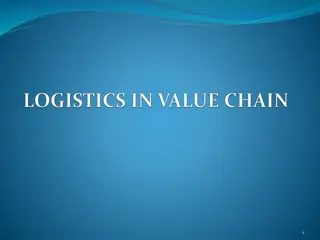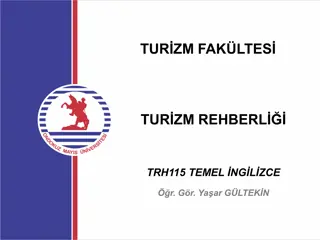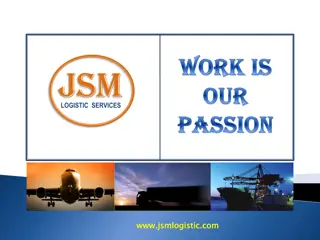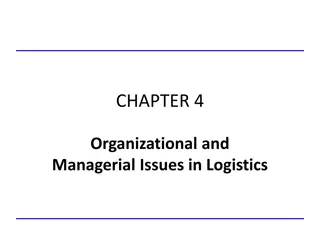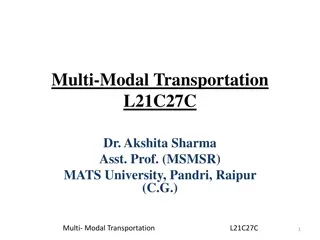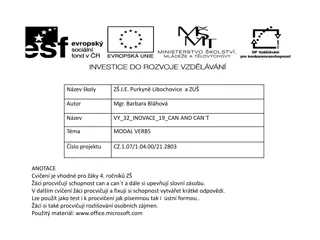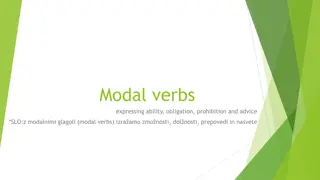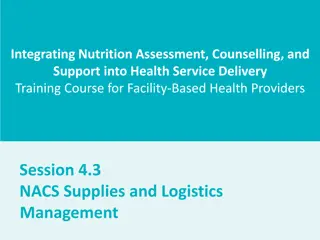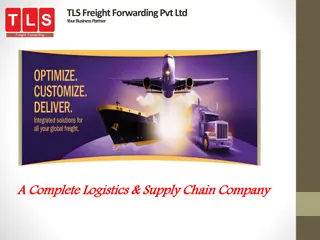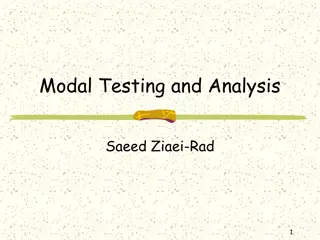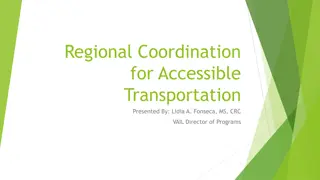Understanding Multi-Modal Transportation in Logistics
The content covers concepts such as inter-modal and multi-modal transportation, seamless supply chains, standard containers, swap bodies, cellular container ships, and unaccompanied road semi-trailers in the context of transportation operations. It explains the meanings and functions of various modes of transport used in logistics, providing valuable insights into the efficient movement of goods.
Download Presentation

Please find below an Image/Link to download the presentation.
The content on the website is provided AS IS for your information and personal use only. It may not be sold, licensed, or shared on other websites without obtaining consent from the author. Download presentation by click this link. If you encounter any issues during the download, it is possible that the publisher has removed the file from their server.
E N D
Presentation Transcript
TRANSPORT OPERATIONS LEVEL 3 2020 LECTURER: Mr SA SIBIYA TRANSPORT AND LOGISTICS L3 LECTUER S GUIDE PUBLISHED IN 2015 BY MACMILLAN SOUTH AFRICA [PTY] LTD
ACTIVITY 3 CORRECTIONS CONCEPT Inter-modal Multi-modal Seamless supply chain MEANING Using more than one mode Using more than two modes A supply chain where responsibility for customer satisfaction is shared by all departments or divisions within a company Roll-on-roll-off or Ro-Ro ships are designed to carry road vehicles. The vehicles can be driven onto the Ro-Ro or by port -based vehicles, for example when loading unaccompanied trailers. There are also Ro-Ros designed specifically to transport rail wagons. RoRo
CONTINUATION OF ACTIVITY 3 Standard container Standard containers usually come in 20- feet, 30-feet, 40-feet, 45 feet and 53-feet lengths. The height and width dimensions are the same for all lengths at eight feet wide by eight six inches high. Swap bodies are containers used for road and rail modes of transport. It has a self- supporting body with legs that can be folded away when necessary. Their lengths are also standardised. Swap bodies are transferred from road vehicles and vice versa by means of an overhead straddle crane. A crane which arms fit into slots at the bottom of a swap body. Unlike containers, swap bodies cannot be stacked. Swap body Straddle crane
CONTINUATION OF ACTIVITY 3 Cellular container ship The cellular container ship is a sea- transport vessel designed specifically for the transport of containers. The containers are stacked on top of each other by means of vertical guides at each corner of the container. The container slots onto the previous one without any need to manoeuver it further. These vessels are sometimes referred to as lift- on-lift-off or LoLo ships. Askeletal trailer is an articulated semi-trailer that is designed too carry containers. It is merely a framework that supports the containers and the containers in fact become the body of the vehicle when loaded on the trailer. Skeletal trailer
CONTINUATION OF ACTIVITY 3 Unaccompanied road semi-trailer Unaccompanied road semi-trailers are used to send goods on Ro-Ro ferries and ships. They do not need adaption of the road trailer and thus avoid the use of a tractive unit and a driver. They are moved by means of a motive unit often call a tug that is fitted with a hydraulic mechanism. This attaches to the front of the trailer and lifts the semi-trailer without raising the landing legs. This speeds up the operation at ports. See cellular container ship. LoLo
CORRECTIONS FOR ACTIVITY 4 TITLE Road Transport Legislation Road Transport Act ACT PURPOSE Act No.74 of1977 Provides for the control of certain forms of road transportation. Promotes the planning and provision of adequate urban transport facilities and the establishment of certain transport funds and transport plans. Describes road traffic regulations, for it to be uniformly applied throughout South Africa. Urban Transport Act Act No. 78 of 1977 National Road Traffic Act (Amendment: 2011) Act No. 93 of 1996
CONTINUATION OF ACTIVITY 4 Cross border Road Transport Act Act No. 4of 1998 Co-ordinates and regulates law enforcement of cross boarder road transport. It provides advice, regulations, facilitation and law enforcement in the cross-boarder road transport by the public and private sectors. Discourages road traffic contraventions through the implementation of a points demerit system. The Act also facilitates the adjudication of road traffic infringements and supports the prosecution of road traffic offences. Administrative Adjudication of Road Traffic Offences Act Act No. 46 of 1998 (Amendment: 2003)
CONTINUATION OF ACTIVITY 4 National Land Transport Act Act No.5 of 2009 Furthers the transformation and restructuring the national land transport system initiated by the Transition Act. Describes the health and safety of all people at work. It also regulates health and safety of people when using plant (machineries). Occupational Health and Safety Act Act No. 85 of 1993
CONTINUATION OF ACTIVITY 4 Explosives Act Act No. 15 of 2003 Controls the use of explosives. Rail Transport National Railway Safety Regulator Act Act No. 16 of 2002 (Amendment: 2011) Provides for the establishment of a railway Safety Regulator, providing for its management and staff matters: to provide for safety standards and regulatory practices for the protection of persons, property and the environment. Furthers the transformation and restructuring of the national land transport system. National Land Transport Act, 2009. Act No. 5 of 2009
CONTINUATION OF ACTIVITY 4 Air Transport Civil Aviation Regulations, Air cargo security/ part 108 Air cargo Security Act No. 1997, part 108 Determines the handling, carriage and management of air cargo to ensure safety and security, as well as the training requirements for personnel handling cargo. Provides for the establishment of International Air services council, for the regulation and control of International air services. International Air Services Act Act No. 60 of 1993 (Amendment: Act No. 10 of 1996
CONTINUATION OF ACTIVITY 4 Carriage by Air Amendment Act Act No. 15 of 2006 (Amendment: Act No. 17 of 1946) Act No. 13 of 2009 (Repeals the Aviation Act, the civil aviation offences Act 10 of 1972 and the South African Civil Aviation Authority Act of 1998) Strives for unification of rules for carriage by air. Civil Aviation Act Draws the provisions of the Acts together and to streamline the regulation of South African Civil Aviation.
CONTINUATION OF ACTIVITY 4 Sea Transport South African Maritime and Aeronautical search and RescueAct Act No.44 of 2002 Established the South African Maritime and Aeronautical Search and Rescue Organisation. To regulate the position of certain documents relating to the carriage of goods by sea. Governs the rights and responsibilities between shippers of cargo and ship owners regarding ocean shipments to and from the United States Sea Transport Documents Act Act No. 65 of 2000 Carriage of goods by seaAct 1986 (COGSA) 36
CONTINUATION OF ACTIVITY 4 Merchant Shipping (Safe Containers Convention) Act No. 10 of 2011 To give effect to the International convention for safe containers and to provide for matters connected therewith.
SUMMARY Learning Outcomes of this Activities Explain the concept multi-modalism in transport operations with reference to the provision of a seamless supply chain, intermodal services and multi-modal opportunities. Describe and compare the different modal options with regard to movement requirements. Tabulate the safety legislation applicable to each transport mode.


